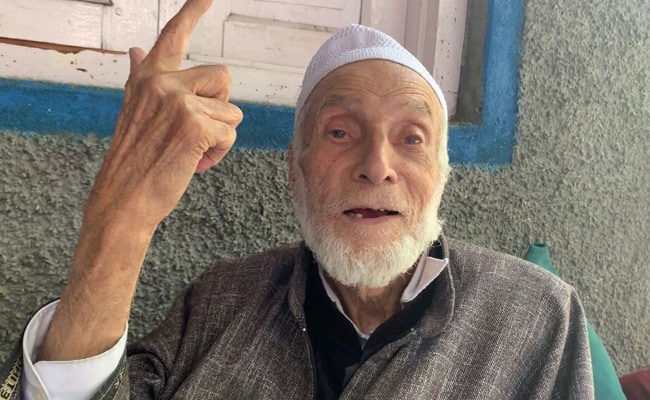

95-year-old Ghulam Nabi Malik lives in Batakote village in Pahalgam.
Jammu and Kashmir:
As Amarnath yatra resumes after a two-year gap, 95-year-old Ghulam Nabi Malik recalls the bond his family shares with the holy cave that his great-grandfather Bota Malik is said to have discovered.
At Batakote village in Pahalgam, Ghulam Nabi Malik recited prayers he used to at the Amarnath holy cave while helping yatris to perform darshan at the cave shrine.
Mr Malik, considered a living legend, has undertaken the yatra for about 60 years. He recalls his family’s association with the cave and how it strengthened the bond between Hindus and Muslims.
The discovery of the cave dates back to 1850 when Bota Malik, a Muslim shepherd is said to have found it with naturally formed ice stalagmite inside it. Since then, Mr Malik’s family conducted the yatra till 2005, when the Amarnath Shrine Board put an end to the age-old practice.
Mr Malik said that he first visited the cave over 70 years ago. He remained part of pilgrimage and began helping people perform the yatra and puja at the cave shrine.
He rues dissociation of family with the cave shrine and blames politics for it. Due to old age, Mr Malik has not been able to visit the cave for many years now but he still recites the puja mantras he used at the cave.
For yatris, the Maliks were always like priests at the cave. The 95-year-old said, “No one would mind if we were Muslims or Hindus.”
His fondest memory involves him accompanying Maharaja Hari Singh’s wife Tara Devi to the cave in 1947. He was gifted a souvenir by Tara Devi as well.
“I first helped people perform yatra at the cave over 70 years ago. I went with Rani (Tara Devi). We held a puja there. Rani gave me a majma, which is a copper tray filled with dates,” he said.
For the Malik family, Bota Malik still remains a revered figure. They said that many yatris consider their journey incomplete unless they visit the family.
However, due to strict security regulations for yatris, no one visits them anymore.
“A spring has sprouted right next to Bota Malik’s grave and we have been collecting drinking water from the same spring for ages now,” Mr Malik said.
His relative Mohammad Akram Malik said yatris who knew the origin of the pilgrimage would visit them to find out more about the Amarnath yatra, about how Bota Malik discovered the cave and the family’s contributions to conduct the yatra.
“Once a group of yatris returned from Shishnag after they heard that the Maliks are living here. They began looking for us. At that time, we were in the hutments in Pahalgam. They said that they had to meet the Maliks before performing darshan,” he said.
This year, stringent security measures have been put in place by the government which has caused hardship to both locals and tourists.
Besides a massive security structure already operating in the Valley, 350 additional companies of the paramilitary have been brought in to guard the yatra.
The Maliks, and many Kashmiris, believe that security should not overshadow the yatra as it represents a long journey of syncretic culture in Kashmir.






